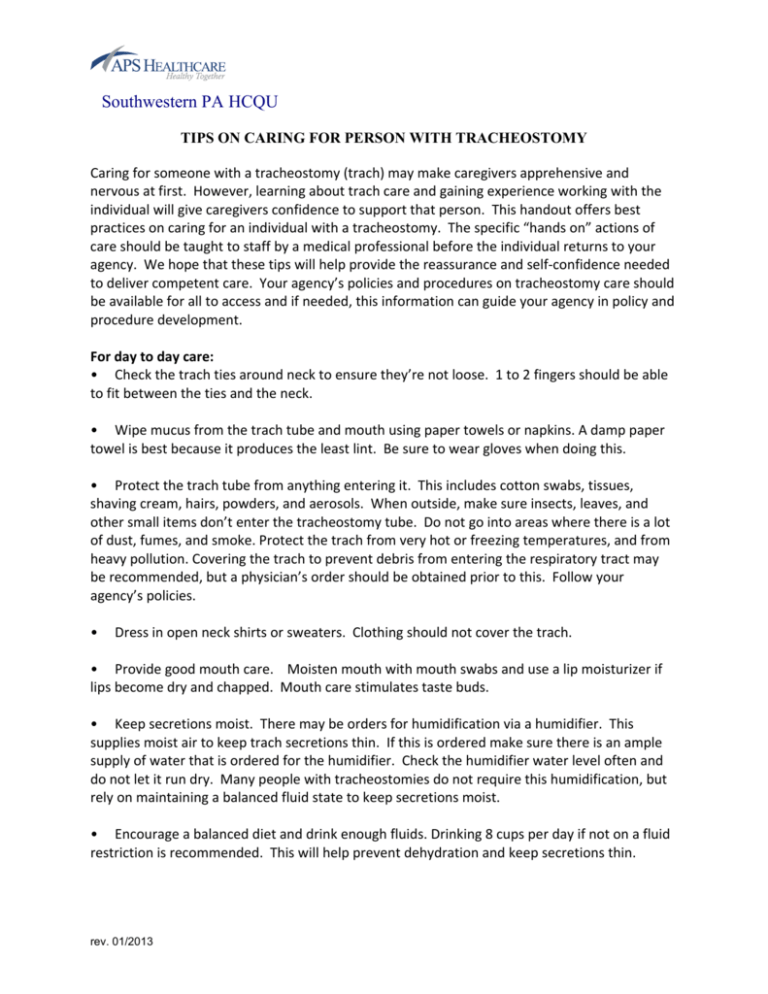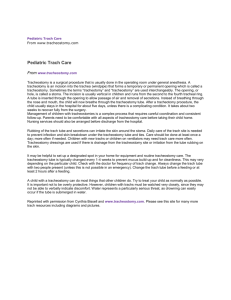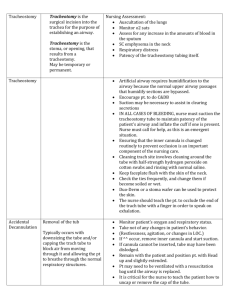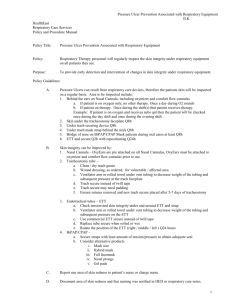Southwestern PA HCQU - Southwestern PA Health Care Quality Unit
advertisement

Southwestern PA HCQU TIPS ON CARING FOR PERSON WITH TRACHEOSTOMY Caring for someone with a tracheostomy (trach) may make caregivers apprehensive and nervous at first. However, learning about trach care and gaining experience working with the individual will give caregivers confidence to support that person. This handout offers best practices on caring for an individual with a tracheostomy. The specific “hands on” actions of care should be taught to staff by a medical professional before the individual returns to your agency. We hope that these tips will help provide the reassurance and self‐confidence needed to deliver competent care. Your agency’s policies and procedures on tracheostomy care should be available for all to access and if needed, this information can guide your agency in policy and procedure development. For day to day care: • Check the trach ties around neck to ensure they’re not loose. 1 to 2 fingers should be able to fit between the ties and the neck. • Wipe mucus from the trach tube and mouth using paper towels or napkins. A damp paper towel is best because it produces the least lint. Be sure to wear gloves when doing this. • Protect the trach tube from anything entering it. This includes cotton swabs, tissues, shaving cream, hairs, powders, and aerosols. When outside, make sure insects, leaves, and other small items don’t enter the tracheostomy tube. Do not go into areas where there is a lot of dust, fumes, and smoke. Protect the trach from very hot or freezing temperatures, and from heavy pollution. Covering the trach to prevent debris from entering the respiratory tract may be recommended, but a physician’s order should be obtained prior to this. Follow your agency’s policies. • Dress in open neck shirts or sweaters. Clothing should not cover the trach. • Provide good mouth care. Moisten mouth with mouth swabs and use a lip moisturizer if lips become dry and chapped. Mouth care stimulates taste buds. • Keep secretions moist. There may be orders for humidification via a humidifier. This supplies moist air to keep trach secretions thin. If this is ordered make sure there is an ample supply of water that is ordered for the humidifier. Check the humidifier water level often and do not let it run dry. Many people with tracheostomies do not require this humidification, but rely on maintaining a balanced fluid state to keep secretions moist. • Encourage a balanced diet and drink enough fluids. Drinking 8 cups per day if not on a fluid restriction is recommended. This will help prevent dehydration and keep secretions thin. rev. 01/2013 Southwestern PA HCQU • Avoid contact with people who have a cold or the flu if possible. People with tracheostomies are at high risk for respiratory infections. The trach tube bypasses the nasal hair and mucus membranes of the upper airway that filter out dust and bacteria. Hand washing before any trach care is one of the best defenses against infection. • Pay attention to the amount and color of the mucus from the trach tube. The doctor should be called if: • The amount of mucus increases • The mucus changes color (yellow or green) • The mucus becomes much thicker • The secretions become bloody • The mucus has a foul odor • A fever of 101f or higher • Difficulty breathing • Congested lung sounds are heard Signs of respiratory distress that need immediate attention may be: Difficulty breathing Increased respiratory rate Increased heart rate Grunting, noisy breathing Whistling noise when breathing Cyanosis (pale, blue color around lips, nail beds, eyes) Restlessness Sweaty, clammy skin Retractions (pulling in of the skin between the ribs, and below the breast bone, above collar bones or in the hollow of the neck) Anxiety, frightened look Flared nostrils Change in pulse or blood pressure Difficulty or refusing to eating Reduced airflow through the tube Also, monitor for an infection of the stoma: Yellow, green, thick drainage noted on the trach dressing Small amount of bleeding on the trach dressing rev. 01/2013 Southwestern PA HCQU Bleeding Sometimes very small amounts of bleeding (pink or red streaked mucus) may occur as a result of routine suctioning. Possible Causes of Minor Bleeding Irritation to the tissue around the stoma Insufficient humidity to the airway Too frequent, deep or vigorous suctioning Suction pressure that is too high Infection Trauma or movement of trach tube Foreign object in the airway Excessive coughing Call your doctor, emergency services, or go directly to your local emergency room for a significant amount of bright red bleeding from the tracheostomy. Follow your agency’s policy. Emergency Plan Develop an emergency plan for all to know and follow. Post CPR instructions for staff to access because delivering respirations during CPR for someone with a trach is performed differently and staff should be trained on this technique. A website with this information is: http://www.cincinnatichildrens.org/health/a/adult‐trach‐cpr/ Follow the guidelines in your agency’s policy. Notify electric, gas and telephone company that you have an individual with a tracheostomy and other medical issues, so that your site is a priority in resuming service in the event of a power outage. Notify police and ambulance services that you have an individual with a trach at your site. Notify the fire department if oxygen is used. Pack an emergency bag to take when traveling. Topics to discuss with doctor Discuss plan of action if trach tube accidentally falls out‐should the old one be reinserted or a replacement? Best practice is to have a new one the same size and one trach tube one size smaller if unable to reinsert the same size trach tube. Should 911 be called and should the individual be seen in ER after the reinsertion? What can be used to protect the trach site in cold weather? What other supplies should be available if the individual attends a day program or workshop‐such as humidifier, resuscitation bag, extra trach pads? Will suctioning be necessary at the day program or workshop, and if so what supplies will be needed? rev. 01/2013 Southwestern PA HCQU Learning to care for someone with a tracheostomy requires the support and individual attention of the person’s entire care team — doctors, respiratory therapist, nurse, and possibly speech therapist and dietitian. Keep their phone numbers available for questions that may arise about specific medical needs. Some websites for more detailed information and pictures are: http://www.nhlbi.nih.gov/health//dci/Diseases/trach/trach_all.html http://www.greenhosp.org/upload/docs/FactSheets/English/genmed_tracheostomy.pdf http://www.upmc.com/patients‐visitors/education/documents/tracheostomycare.pdf rev. 01/2013





